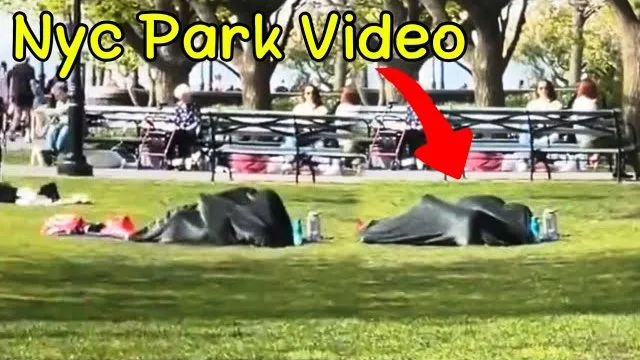 |
| nyc park couple under blanket |
For Video Scroll to End. In the heart of New York City, Central Park stood as a sprawling oasis amidst the concrete jungle. Its lush greenery and winding pathways offered solace to countless urban dwellers seeking respite from the hustle and bustle of city life. Yet, within its verdant embrace, shadows lurked, waiting to cast a veil over the park's tranquility.
One bright afternoon, as families picnicked and children played, a couple found themselves entwined in a secluded corner of the park. With a blanket spread beneath them, they sought refuge from prying eyes, their whispers drowned out by the laughter of nearby children. Oblivious to the world around them, they surrendered to the moment, heedless of the boundaries of decency.
Unbeknownst to them, their intimate embrace did not go unnoticed. A young mother, pushing her stroller along the path, caught sight of the couple through the dense foliage. Shock and disbelief clouded her features as she shielded her child's innocent eyes from the scene unfolding before them. In that moment, the park's sanctuary was shattered, replaced by a palpable sense of discomfort and unease.
Word of the incident spread like wildfire, igniting a flurry of conversations and debates across the city. Some condemned the couple's actions as brazen and disrespectful, while others lamented the lack of privacy in public spaces. Amidst the clamor, calls for accountability echoed through the corridors of power, demanding swift action to ensure the safety and sanctity of the park for all.
As the sun set on Central Park, casting long shadows across its expanse, the couple's clandestine rendezvous served as a sobering reminder of the delicate balance between personal freedom and communal responsibility. In the city that never sleeps, even the most intimate moments could not escape the watchful gaze of its inhabitants, leaving a lingering question hanging in the air: in the shadows of the park, where does privacy end and public decency begin?
Addressing such an event involves delicate consideration due to its sensitive nature. However, discussing potential implications can shed light on the consequences and underlying factors:
Pros and Cons:
Pros:
Awareness: Such incidents can raise awareness about the need for vigilance in public spaces and the importance of appropriate behavior around children.
Community Response: They may prompt communities to advocate for increased safety measures and enforcement in public areas.
Cons:
Trauma: Witnessing such acts can be deeply distressing and traumatic for children and other bystanders, potentially causing long-term psychological harm.
Public Image: Events like these tarnish the reputation of the park and the city, impacting tourism and community morale.
Consequences:
Legal Ramifications: The individuals involved could face legal consequences, including charges related to public indecency and endangering the welfare of children.
Social Fallout: The incident may lead to social stigma for the individuals involved, affecting their personal and professional lives.
Underlying Reasons:
Lack of Awareness: Some individuals may not realize the inappropriate nature of their actions or the impact they have on others, especially in public settings.
Risk-Taking Behavior: Factors such as alcohol or drug use, impulsivity, or a disregard for social norms may contribute to risky behavior in public.
Normalization of Sexuality: In some cases, there may be a misunderstanding or misinterpretation of societal norms regarding appropriate expressions of intimacy in public spaces.
Addressing such events requires a multifaceted approach, including education, enforcement of laws, and community support services. By fostering a culture of respect and responsibility, communities can work towards preventing similar incidents in the future.
space constraints can potentially contribute to such incidents. In crowded urban areas like New York City, where public parks may be densely populated, finding privacy can be challenging. Couples seeking intimacy may feel limited in their options and may make poor judgments about where and when it's appropriate to engage in private activities.
Factors Contributing to Space Issues:
Overcrowding: Parks in urban areas often experience high foot traffic, particularly during peak times. Finding secluded spots away from others can be difficult.
Lack of Private Spaces: Many public parks lack designated areas for privacy or intimacy, leaving individuals with limited options if they seek seclusion.
Urban Density: In densely populated cities like New York, residents may have limited access to private spaces due to high-rise buildings and limited green spaces.
Consequences of Space Constraints:
Risk-Taking Behavior: When individuals feel restricted in their ability to find privacy, they may resort to risky behavior, such as engaging in intimate activities in public spaces.
Increased Visibility: Limited privacy in public parks means that intimate activities are more likely to be observed by others, including children and families, leading to potential discomfort or distress.
Legal and Social Ramifications: Engaging in intimate activities in public spaces is often against the law and can result in legal consequences. Additionally, it can lead to social stigma and reputational damage for those involved.




